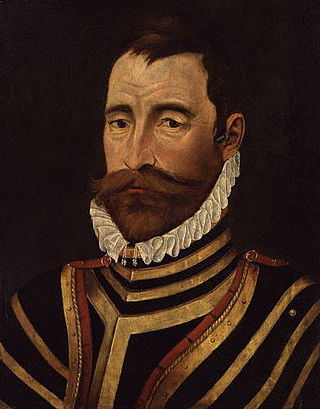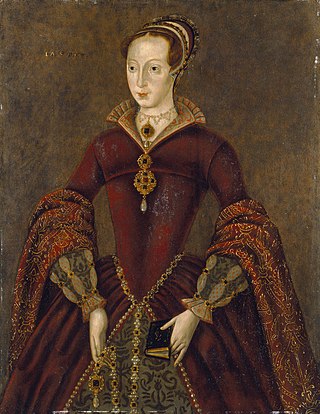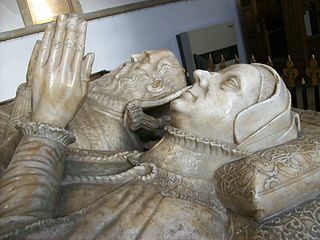Related Research Articles

Elizabeth I was Queen of England and Ireland from 17 November 1558 until her death in 1603. She was the last monarch of the House of Tudor.

Mary I, also known as Mary Tudor, and as "Bloody Mary" by her Protestant opponents, was Queen of England and Ireland from July 1553 and Queen of Spain and the Habsburg dominions as the wife of King Philip II from January 1556 until her death in 1558. She is best known for her vigorous attempt to reverse the English Reformation, which had begun during the reign of her father, King Henry VIII. Her attempt to restore to the Church the property confiscated in the previous two reigns was largely thwarted by Parliament, but during her five-year reign, Mary had over 280 religious dissenters burned at the stake in the Marian persecutions.

The House of Tudor was an English and Welsh dynasty that held the throne of England from 1485 to 1603. They descended from the Tudors of Penmynydd, a Welsh noble family, and Catherine of Valois. The Tudor monarchs ruled the Kingdom of England and the Lordship of Ireland for 118 years with five monarchs: Henry VII, Henry VIII, Edward VI, Mary I and Elizabeth I. The Tudors succeeded the House of Plantagenet as rulers of the Kingdom of England, and were succeeded by the Scottish House of Stuart. The first Tudor monarch, Henry VII, descended through his mother from the House of Beaufort, a legitimised branch of the English royal House of Lancaster, a cadet house of the Plantagenets. The Tudor family rose to power and started the Tudor period in the wake of the Wars of the Roses (1455–1487), which left the main House of Lancaster extinct in the male line.

Mary of Guise, also called Mary of Lorraine, was Queen of Scotland from 1538 until 1542, as the second wife of King James V. She was a French noblewoman of the House of Guise, a cadet branch of the House of Lorraine and one of the most powerful families in France. As the mother of Mary, Queen of Scots, she was a key figure in the political and religious upheaval that marked mid-16th-century Scotland, ruling the kingdom as queen regent on behalf of her daughter from 1554 until her death in 1560.

Elizabeth is a 1998 British biographical period drama film directed by Shekhar Kapur and written by Michael Hirst. It stars Cate Blanchett in the title role of Elizabeth I of England, with Geoffrey Rush, Christopher Eccleston, Joseph Fiennes, John Gielgud, and Richard Attenborough in supporting roles. The film is based on the early years of Elizabeth's reign, where she is elevated to the throne after the death of her half-sister Mary I, who had imprisoned her. As she establishes herself on the throne, she faces plots and threats to take her down.

Thomas Howard, 3rd Duke of Norfolk, was a prominent English politician and nobleman of the Tudor era. He was an uncle of two of the wives of King Henry VIII, Anne Boleyn and Catherine Howard, both of whom were beheaded, and played a major role in the machinations affecting these royal marriages. After falling from favour in 1546, he was stripped of his dukedom and imprisoned in the Tower of London, avoiding execution when Henry VIII died on 28 January 1547.

Thomas Howard, 4th Duke of Norfolk, was an English nobleman and politician. He was a second cousin of Queen Elizabeth I and held many high offices during the earlier part of her reign.

James VI and I was King of Scotland as James VI from 24 July 1567 and King of England and Ireland as James I from the union of the Scottish and English crowns on 24 March 1603 until his death in 1625. Although he long tried to get both countries to adopt a closer political union, the kingdoms of Scotland and England remained individual sovereign states, with their own parliaments, judiciaries, and laws, both ruled by James in personal union. He was the longest-reigning monarch of the Kingdom of Scotland.

Lady Mary Keyes was the youngest daughter of Henry Grey, 1st Duke of Suffolk, and Frances Brandon, and through her mother had a claim on the crown of England.

Katherine Brandon, Duchess of Suffolk, suo jure12th Baroness Willoughby de Eresby, was an English noblewoman living at the courts of King Henry VIII, King Edward VI and Queen Elizabeth I. She was the fourth wife of Charles Brandon, 1st Duke of Suffolk, who acted as her legal guardian during his third marriage to Henry VIII's sister Mary. Her second husband was Richard Bertie, a member of her household. Following Charles Brandon's death in 1545, it was rumoured that King Henry had considered marrying Katherine as his seventh wife, while he was still married to his sixth wife, Catherine Parr, who was Katherine's close friend.

Antoine, 1st comte de Noailles became admiral of France, and was ambassador in England for three years, 1553–1556, maintaining a gallant but unsuccessful rivalry with the Spanish ambassador, Simon Renard.

Wyatt's Rebellion was a limited and unsuccessful uprising in England in early 1554 led by four men, one of whom was Sir Thomas Wyatt. It was given its name by the lawyer at Wyatt's arraignment, who stated for the record that "this shall be ever called Wyat's Rebellion". The rebellion arose out of concern over Queen Mary I's determination to marry a foreigner, Philip II of Spain, and to return England to the Catholic Church and papal authority. The uprising failed, with consequences for the rebels that ranged from death to forgiveness.

Sir William Drury was an English statesman and soldier.

Jane Neville, Countess of Westmorland, was an English noblewoman.

Lady Jane Grey, also known as Lady Jane Dudley after her marriage and as the "Nine Days' Queen", was an English noblewoman who claimed the throne of England and Ireland from 10 to 19 July 1553.
Lady Elizabeth Stafford was an English aristocrat. She was the eldest daughter of Edward Stafford, 3rd Duke of Buckingham and Lady Eleanor Percy. By marriage she became Duchess of Norfolk. Her abusive marriage to Thomas Howard, 3rd Duke of Norfolk, created a public scandal.

John Williams, 1st Baron Williams of Thame was Master of the Jewels and Lord President of the Council of the Welsh Marches. He was summoned to parliament as Lord Williams of Thame on 17 February 1554.
Isabella Markham, was an English courtier, a Gentlewoman of the Privy Chamber of Queen Elizabeth I of England and a personal favourite of the queen. Isabella Markham was muse to the court official and poet John Harington, who wrote sonnets and poems addressed to her, before and after they married. Thomas Palfreyman dedicated his Divine Meditations to her in 1572.
Mary de Vere was a 16th-century English noblewoman. The daughter of John de Vere, 16th Earl of Oxford, and his second wife Margery Golding, she married Peregrine Bertie, 13th Baron Willoughby de Eresby. The couple lived with their seven children in Grimsthorpe Castle in Lincolnshire. Following Bertie's death, Lady Willoughby married Sir Eustace Hart. She died on about 24 June 1624.

Margaret Croft or Crofts was an English aristocrat.
References
- ↑ Prescott, H.F.M. (2012). Mary Tudor. p. XV. ISBN 978-1780225012.
- ↑ John Stow. The Pennance of Elizabeth Crofts, for Molesting the Citizens of London with strange noises (1554), in Helme, William. Curious Miscellaneous Fragments On Various Subjects (1815)
- 1 2 Daniel Hahn, ‘Crofts, Elizabeth (b. c.1535)’, Oxford Dictionary of National Biography, Oxford University Press, 2004 accessed 7 Dec 2014